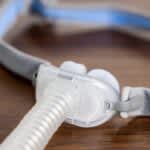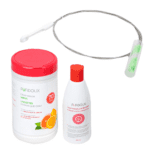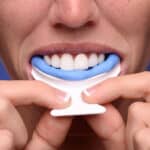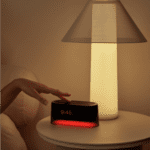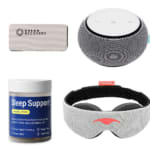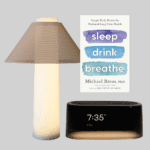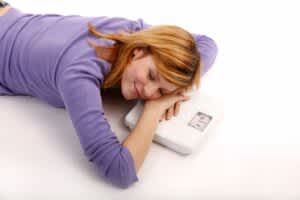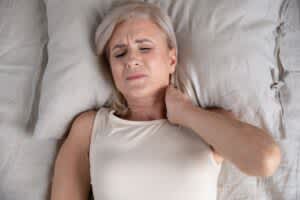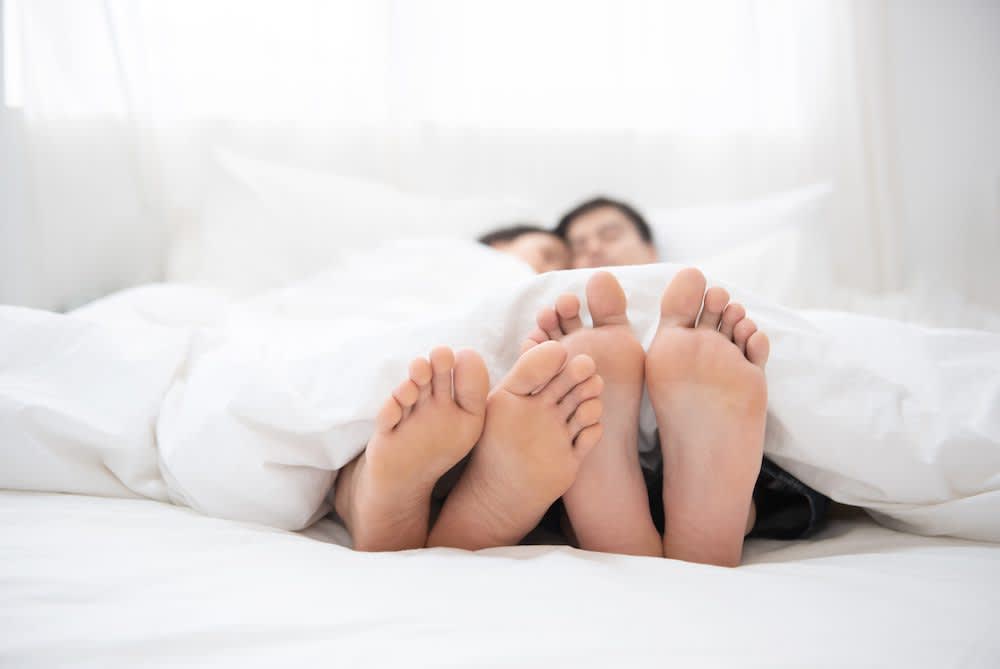Exercise influences sleep on both a physical and mental level. Understanding this complex relationship is key to creating an effective exercise routine.
Top 5 Exercise Tips for Better Sleep

- 1 Exercise every day for at least 30 minutes.
- 2 Try times of day to find the routine that works best for you.
- 3 Adjust your sleep needs after more intense workouts.
- 4 Try a fitness tracker that also provides insight into your sleep health.
- 5 Exercise outdoors to help regulate your circadian rhythm.
Aerobic exercise, resistance training, and yoga can all help promote better sleep.
Sleep Benefits of Exercise
Approximately one-third of Americans don’t get enough sleep on a regular basis. Exercise during the day has been shown to improve sleep efficiency and duration for adults, particularly those who live with chronic disease. Not getting enough rest has also been linked to sluggishness and physical inactivity the following day, suggesting a bidirectional relationship between sleep and exercise.
While regular physical activity has numerous benefits for your overall health and well-being, intensity and timing are important when planning exercise for sleep. According to current guidelines, vigorous exercise is not recommended within three hours of your bedtime.
Exercise Tires the Body
Physical demanding activities such as exercise increase the pressure to sleep that naturally builds throughout the day. This pressure – also known as the homeostatic sleep drive – increases while you’re awake. Sleeping resets your sleep drive, which begins anew when you wake up the following day.
A physically demanding job can also expedite the sleep drive, but exercise is considered better for sleep quality. This is because people with jobs with strong physical demands often experience musculoskeletal pain that can disturb sleep.
Exercise Helps You Fall Asleep Faster
Pre-sleep anxiety is a common experience for many people, particularly those with insomnia. Over time, anxiety about sleep can condition people to associate their bed with stress and worry, which in turn can compound these anxious feelings. Exercise can alleviate symptoms of anxiety through biological and psychological means. Physical activity distracts people from thoughts or feelings that trigger anxiety, and also triggers processes in the brain that inhibit stress.
Among older adults, several forms of exercise appear to help improve sleep. These include aerobic exercise, resistance training, yoga, and tai chi. However, one study found that mind-body exercises such as yoga or tai chi were most effective, and offered additional benefits like improved mood and mental health. Exercising the mind as well as the body may enable more restful sleep.
Outdoor Exercise Reinforces Circadian Rhythms
Exposure to bright light, especially in the morning, can help regulate the body’s internal body clock and promote sleep at night. Some research suggests that exercising outdoors in the morning may help reinforce these natural rhythms. This benefit may be particularly helpful for older adults since circadian rhythms can become weaker with age.
Natural light plays a prominent role in circadian rhythm. Daylight entering the eyes sends signals to your circadian clock, triggering the production of hormones like cortisol and adrenaline that keep you alert. The circadian clock is also signaled when the sun goes down in the evening and your body produces melatonin, a hormone that promotes feelings of sleepiness and relaxation. People who struggle with sleep often benefit from exposure to natural light when they are awake, so exercising outdoors during the day can improve sleep in two different yet effective ways.
What Type of Exercise is Best for Sleep?
Aerobic Exercise & Cardio
Aerobic exercise raises your heart rate and increases blood flow. It can also reduce blood pressure and reduce your risk for cardiovascular disease. Aerobic exercise has shown to be particularly impactful for people with insomnia and other sleep disorders. This type of exercise can improve total sleep time, ability to sleep through the night, and overall sleep quality. It can also help people with insomnia fall asleep faster, leading some researchers to recommend aerobic exercise as a treatment for the disorder.
Moderate- to high-intensity exercise has been shown to reduce anxiety for several hours. In one study, a single session of moderate-intensity aerobic exercise significantly reduced the anxiety of people with insomnia. This type of exercise also cut the time it took them to fall asleep in half while increasing the amount of time they spent asleep overall.
Resistance Training
Aerobic activity isn’t the only type of exercise that can help you get extra sleep. If running isn’t your thing, lifting weights and other resistance training can have the same benefits. Studies have shown that doing any muscle-strengthening exercise (MSE) is associated with better sleep quality.
Resistance training is a form of exercise that makes your muscles work against a weight or force. Some examples of this type of exercise include:
- Lifting weights
- Using resistance bands
- Bodyweight workouts like pull-ups
Yoga
Yoga is a great way to promote mental and physical well-being. It focuses on meditation, breathing, and holding different postures. Research suggests that yoga can help alleviate stress, reduce anxiety and depression, and promote mental well-being. It has also been shown to improve sleep in many populations, including cancer patients, and people struggling with symptoms of menopause or arthritis.
When is the Best Time to Exercise for Sleep?
Everyone responds to exercise differently, so there is no “one-size-fits-all” routine guaranteed to improve your sleep. That said, studies have found that aerobic exercise in the early morning can help you fall asleep more quickly, improve your sleep quality, and reduce the time you spend awake at night better than this type of exercise in the afternoon or evening. Light exercise in the evening such as stretching or yoga can also help you unwind for bed without exerting your body too much.

Exercising in the Morning is Best for Sleep
Exercising in the morning also affects your heart rate, but not in the same way as evening exercise. Morning exercise has been linked to an increase in very low frequency, low frequency, and high frequency heart rate activity. This balance promotes parasympathetic activity in the central nervous system during sleep, which is associated with calm and relaxation.
In contrast, the spike in heart rate that occurs after evening exercise is thought to enhance sympathetic activity, which is associated with stress and “fight or flight” feelings. Researchers have theorized that exercising earlier in the day gives the body enough time to calm down and let the parasympathetic nervous system kick in, allowing one to relax before sleep. As a result, morning exercise is believed to produce more restful sleep compared to evening exercise.
Nighttime Exercise can Decrease REM Sleep
Researchers have observed physiological changes that occur after nighttime exercise. One of these changes is a spike in body temperature, which can interfere with the natural decline in core temperature that occurs as part of the 24-hour circadian cycle. Evening exercise can also elevate the heart rate, and studies have shown people who exercise at night may experience a decrease in rapid eye movement (REM) sleep. These changes have not been observed as consistently in people who exercise in the morning.
Depending on your daily schedule, exercising at night might be the most convenient option. While some people may benefit from light exercise closer to bed, most experts agree vigorous physical activity can make it harder to fall asleep, reduce total sleep time, and negatively affect sleep efficiency.
This is not to say all nighttime exercise is inherently bad or unhealthy. A study of healthy college-aged people showed that resistance exercise consistently improved their sleep, whether they worked out in the morning, afternoon, or evening. Those who worked out in the morning tended to fall asleep faster, but those who worked out in the evening slept more soundly, waking up less frequently through the night.
Timing High-Intensity Workouts
Most exercises are considered moderate- or high-intensity. When you engage in high-intensity – also known as vigorous-intensity – exercises, you will need to pause for a breath after speaking only a few words. Examples of high-intensity exercise include running or jogging, lap-swimming, cycling at least 10 miles, or uphill hiking.
High-intensity exercise prior to bedtime has been shown to increase heart rate and delay sleep onset, making it harder to fall asleep. In one study, a group of physically fit men performed either a moderate- or high-intensity workout before going to bed. Those who engaged in the latter had a higher heart rate and took 14 more minutes to fall asleep compared to those who performed a moderate-intensity workout.
However, some studies have shown just the opposite: that intense exercise may help people sleep more deeply. When a group of physically active adults exercised 90 minutes before bed, those who felt they had worked out harder had more restorative deep sleep than those who felt they had worked out less. They also fell asleep faster, woke up less during the night, and spent less time awake in bed.
The best time to engage in high-intensity exercise may depend on chronotype, which refers to biological dispositions for sleeping earlier or later in the day. Morning people or “larks” tend to rise and sleep earlier in the day, whereas evening people or “owls” rise and sleep later in the day. One study found that chronotypes can play a major role in athletic performance at different times of day and night, suggesting people may want to consider timing their high-intensity workouts based on whether they are a morning or evening person.
Shop the Best Mattresses for AthletesExercise Tips for Getting Better Sleep
Regular exercise is a key component of healthy sleep hygiene. Originally conceived as a possible treatment for insomnia, sleep hygiene refers to a set of behavioral and environmental strategies for promoting healthy sleep on a regular basis. Other important aspects of sleep hygiene include:
- Exercise for 30 minutes: Prioritize your health and sleep by committing to 30 minutes of moderate exercise every day. This could be as simple as taking your dog for a walk, or sun salutations when you wake up. You don’t need to overdo it – while longer and more intense workouts will improve your physical health, you will see sleep benefits after 30 minutes of activity.
- Experiment to see what works best for you: Working out in the morning doesn’t work for everyone. Try different things to find the routine that works for you. Consistency is key – find a time and regime that fits into your life.
- Get regular sleep for more intense workouts: There is a bidirectional relationship between sleep and exercise. While exercise can help you fall asleep, getting enough sleep can also help your workouts. You’ll be more inclined to get up and go to the gym after a good night’s sleep.
- Try a fitness tracker: Fitness trackers are great for recording workouts and staying motivated, but most fitness trackers also come with comprehensive sleep data. Having this data at your fingertips can help you determine which routine fits your life the best. It can also give you valuable insights into your sleep cycle, which you can use to optimize your workouts and health.
- Stay hydrated: Factors like exercise, sweating, and heat can impact your body’s ability to stay hydrated. Aim for 8 ounces of fluid every hour to prevent excessive water loss. If you live an active lifestyle or your work requires physical labor, increase your daily intake of water and electrolytes to offset dehydration.
For help improving your sleep hygiene and finding an appropriate workout routine for your health goals, talk to your doctor or a professional sleep specialist.
References
The Sleep Doctor Forum: Real Experiences, Real Connections
Continue the discussion on the Sleep Doctor Forum. Connect with experts and fellow forum members on CPAP, sleep apnea, and all things sleep. A priceless resource that’s free to join.



